Business Law 1702 - Tort Law: Negligence Analysis in Delivery Cases
VerifiedAdded on 2023/06/04
|6
|1407
|52
Case Study
AI Summary
This assignment presents a case study analyzing tort law principles, specifically negligence, in the context of delivery driving scenarios. It examines three distinct examples: a driver hitting a pedestrian, a driver rear-ending another vehicle, and a truck sliding off the road due to a snowstorm. For eac...
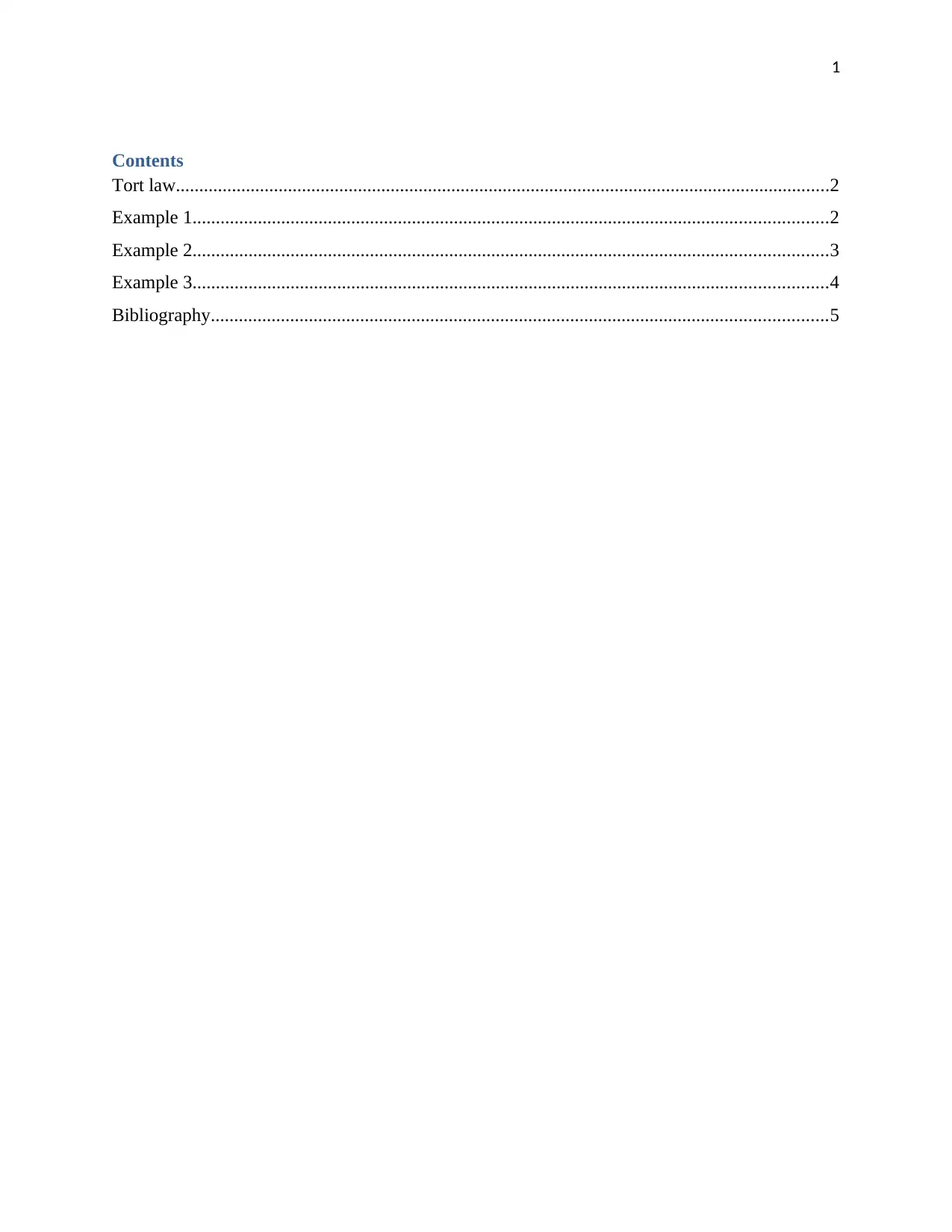
1
Contents
Tort law............................................................................................................................................2
Example 1........................................................................................................................................2
Example 2........................................................................................................................................3
Example 3........................................................................................................................................4
Bibliography....................................................................................................................................5
Contents
Tort law............................................................................................................................................2
Example 1........................................................................................................................................2
Example 2........................................................................................................................................3
Example 3........................................................................................................................................4
Bibliography....................................................................................................................................5
Paraphrase This Document
Need a fresh take? Get an instant paraphrase of this document with our AI Paraphraser
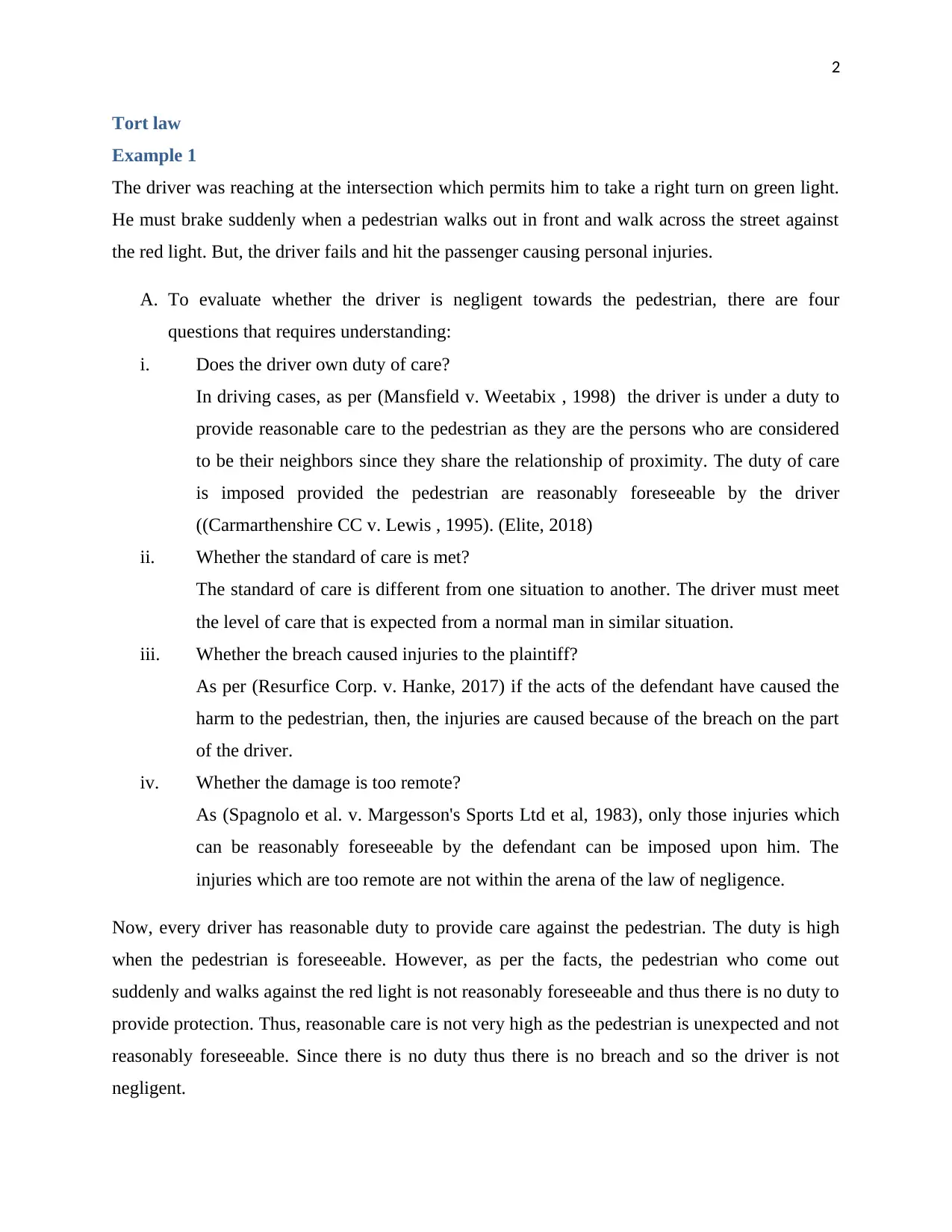
2
Tort law
Example 1
The driver was reaching at the intersection which permits him to take a right turn on green light.
He must brake suddenly when a pedestrian walks out in front and walk across the street against
the red light. But, the driver fails and hit the passenger causing personal injuries.
A. To evaluate whether the driver is negligent towards the pedestrian, there are four
questions that requires understanding:
i. Does the driver own duty of care?
In driving cases, as per (Mansfield v. Weetabix , 1998) the driver is under a duty to
provide reasonable care to the pedestrian as they are the persons who are considered
to be their neighbors since they share the relationship of proximity. The duty of care
is imposed provided the pedestrian are reasonably foreseeable by the driver
((Carmarthenshire CC v. Lewis , 1995). (Elite, 2018)
ii. Whether the standard of care is met?
The standard of care is different from one situation to another. The driver must meet
the level of care that is expected from a normal man in similar situation.
iii. Whether the breach caused injuries to the plaintiff?
As per (Resurfice Corp. v. Hanke, 2017) if the acts of the defendant have caused the
harm to the pedestrian, then, the injuries are caused because of the breach on the part
of the driver.
iv. Whether the damage is too remote?
As (Spagnolo et al. v. Margesson's Sports Ltd et al, 1983), only those injuries which
can be reasonably foreseeable by the defendant can be imposed upon him. The
injuries which are too remote are not within the arena of the law of negligence.
Now, every driver has reasonable duty to provide care against the pedestrian. The duty is high
when the pedestrian is foreseeable. However, as per the facts, the pedestrian who come out
suddenly and walks against the red light is not reasonably foreseeable and thus there is no duty to
provide protection. Thus, reasonable care is not very high as the pedestrian is unexpected and not
reasonably foreseeable. Since there is no duty thus there is no breach and so the driver is not
negligent.
Tort law
Example 1
The driver was reaching at the intersection which permits him to take a right turn on green light.
He must brake suddenly when a pedestrian walks out in front and walk across the street against
the red light. But, the driver fails and hit the passenger causing personal injuries.
A. To evaluate whether the driver is negligent towards the pedestrian, there are four
questions that requires understanding:
i. Does the driver own duty of care?
In driving cases, as per (Mansfield v. Weetabix , 1998) the driver is under a duty to
provide reasonable care to the pedestrian as they are the persons who are considered
to be their neighbors since they share the relationship of proximity. The duty of care
is imposed provided the pedestrian are reasonably foreseeable by the driver
((Carmarthenshire CC v. Lewis , 1995). (Elite, 2018)
ii. Whether the standard of care is met?
The standard of care is different from one situation to another. The driver must meet
the level of care that is expected from a normal man in similar situation.
iii. Whether the breach caused injuries to the plaintiff?
As per (Resurfice Corp. v. Hanke, 2017) if the acts of the defendant have caused the
harm to the pedestrian, then, the injuries are caused because of the breach on the part
of the driver.
iv. Whether the damage is too remote?
As (Spagnolo et al. v. Margesson's Sports Ltd et al, 1983), only those injuries which
can be reasonably foreseeable by the defendant can be imposed upon him. The
injuries which are too remote are not within the arena of the law of negligence.
Now, every driver has reasonable duty to provide care against the pedestrian. The duty is high
when the pedestrian is foreseeable. However, as per the facts, the pedestrian who come out
suddenly and walks against the red light is not reasonably foreseeable and thus there is no duty to
provide protection. Thus, reasonable care is not very high as the pedestrian is unexpected and not
reasonably foreseeable. Since there is no duty thus there is no breach and so the driver is not
negligent.
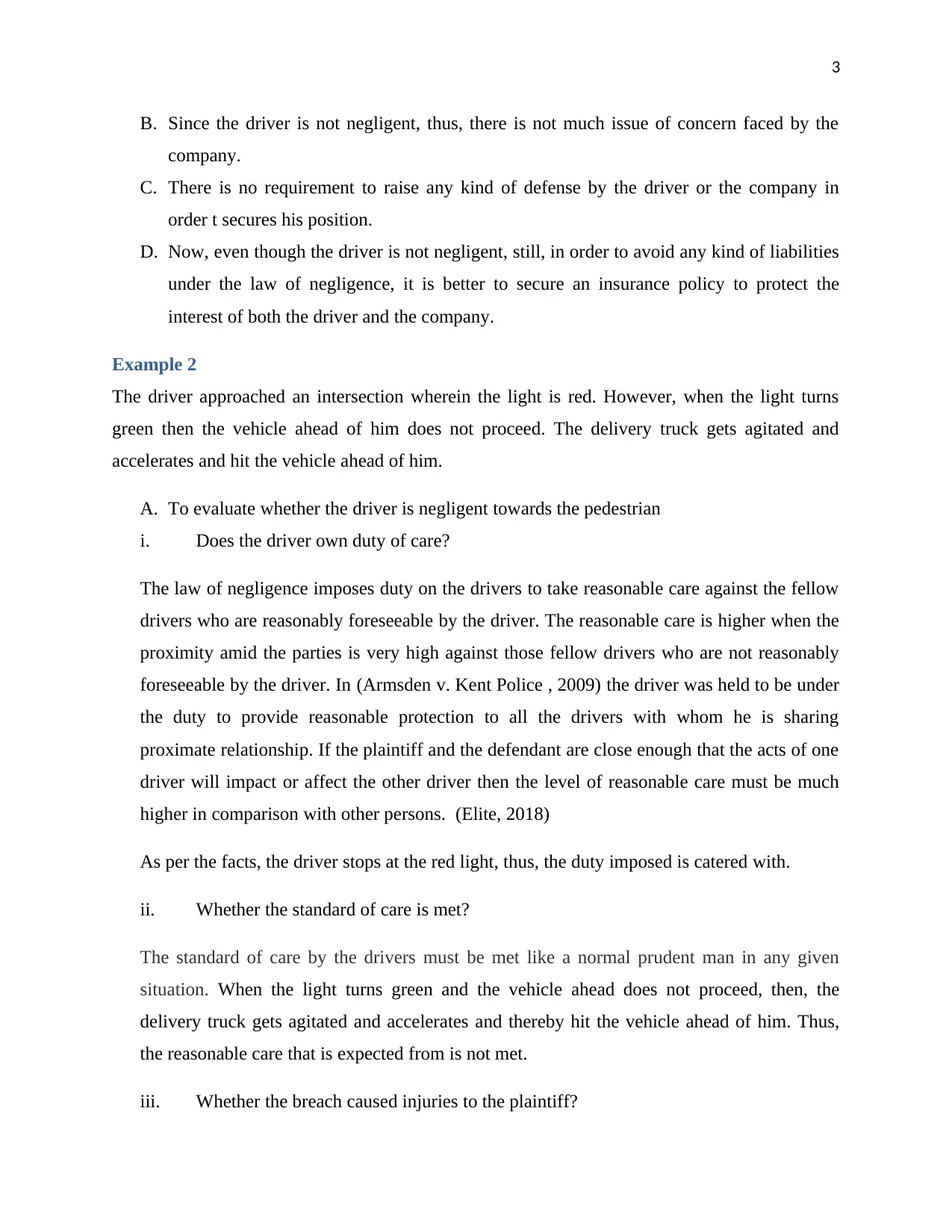
3
B. Since the driver is not negligent, thus, there is not much issue of concern faced by the
company.
C. There is no requirement to raise any kind of defense by the driver or the company in
order t secures his position.
D. Now, even though the driver is not negligent, still, in order to avoid any kind of liabilities
under the law of negligence, it is better to secure an insurance policy to protect the
interest of both the driver and the company.
Example 2
The driver approached an intersection wherein the light is red. However, when the light turns
green then the vehicle ahead of him does not proceed. The delivery truck gets agitated and
accelerates and hit the vehicle ahead of him.
A. To evaluate whether the driver is negligent towards the pedestrian
i. Does the driver own duty of care?
The law of negligence imposes duty on the drivers to take reasonable care against the fellow
drivers who are reasonably foreseeable by the driver. The reasonable care is higher when the
proximity amid the parties is very high against those fellow drivers who are not reasonably
foreseeable by the driver. In (Armsden v. Kent Police , 2009) the driver was held to be under
the duty to provide reasonable protection to all the drivers with whom he is sharing
proximate relationship. If the plaintiff and the defendant are close enough that the acts of one
driver will impact or affect the other driver then the level of reasonable care must be much
higher in comparison with other persons. (Elite, 2018)
As per the facts, the driver stops at the red light, thus, the duty imposed is catered with.
ii. Whether the standard of care is met?
The standard of care by the drivers must be met like a normal prudent man in any given
situation. When the light turns green and the vehicle ahead does not proceed, then, the
delivery truck gets agitated and accelerates and thereby hit the vehicle ahead of him. Thus,
the reasonable care that is expected from is not met.
iii. Whether the breach caused injuries to the plaintiff?
B. Since the driver is not negligent, thus, there is not much issue of concern faced by the
company.
C. There is no requirement to raise any kind of defense by the driver or the company in
order t secures his position.
D. Now, even though the driver is not negligent, still, in order to avoid any kind of liabilities
under the law of negligence, it is better to secure an insurance policy to protect the
interest of both the driver and the company.
Example 2
The driver approached an intersection wherein the light is red. However, when the light turns
green then the vehicle ahead of him does not proceed. The delivery truck gets agitated and
accelerates and hit the vehicle ahead of him.
A. To evaluate whether the driver is negligent towards the pedestrian
i. Does the driver own duty of care?
The law of negligence imposes duty on the drivers to take reasonable care against the fellow
drivers who are reasonably foreseeable by the driver. The reasonable care is higher when the
proximity amid the parties is very high against those fellow drivers who are not reasonably
foreseeable by the driver. In (Armsden v. Kent Police , 2009) the driver was held to be under
the duty to provide reasonable protection to all the drivers with whom he is sharing
proximate relationship. If the plaintiff and the defendant are close enough that the acts of one
driver will impact or affect the other driver then the level of reasonable care must be much
higher in comparison with other persons. (Elite, 2018)
As per the facts, the driver stops at the red light, thus, the duty imposed is catered with.
ii. Whether the standard of care is met?
The standard of care by the drivers must be met like a normal prudent man in any given
situation. When the light turns green and the vehicle ahead does not proceed, then, the
delivery truck gets agitated and accelerates and thereby hit the vehicle ahead of him. Thus,
the reasonable care that is expected from is not met.
iii. Whether the breach caused injuries to the plaintiff?
⊘ This is a preview!⊘
Do you want full access?
Subscribe today to unlock all pages.

Trusted by 1+ million students worldwide
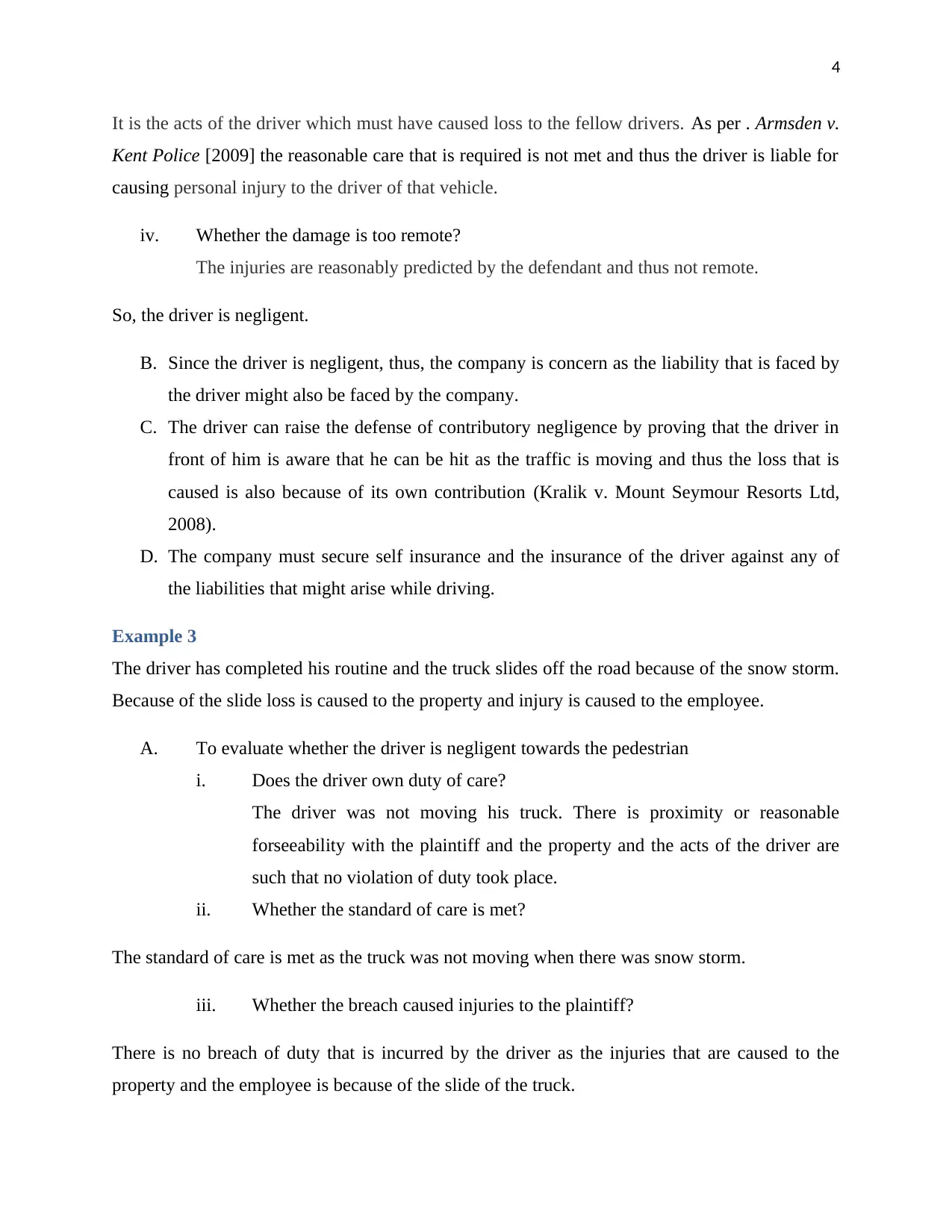
4
It is the acts of the driver which must have caused loss to the fellow drivers. As per . Armsden v.
Kent Police [2009] the reasonable care that is required is not met and thus the driver is liable for
causing personal injury to the driver of that vehicle.
iv. Whether the damage is too remote?
The injuries are reasonably predicted by the defendant and thus not remote.
So, the driver is negligent.
B. Since the driver is negligent, thus, the company is concern as the liability that is faced by
the driver might also be faced by the company.
C. The driver can raise the defense of contributory negligence by proving that the driver in
front of him is aware that he can be hit as the traffic is moving and thus the loss that is
caused is also because of its own contribution (Kralik v. Mount Seymour Resorts Ltd,
2008).
D. The company must secure self insurance and the insurance of the driver against any of
the liabilities that might arise while driving.
Example 3
The driver has completed his routine and the truck slides off the road because of the snow storm.
Because of the slide loss is caused to the property and injury is caused to the employee.
A. To evaluate whether the driver is negligent towards the pedestrian
i. Does the driver own duty of care?
The driver was not moving his truck. There is proximity or reasonable
forseeability with the plaintiff and the property and the acts of the driver are
such that no violation of duty took place.
ii. Whether the standard of care is met?
The standard of care is met as the truck was not moving when there was snow storm.
iii. Whether the breach caused injuries to the plaintiff?
There is no breach of duty that is incurred by the driver as the injuries that are caused to the
property and the employee is because of the slide of the truck.
It is the acts of the driver which must have caused loss to the fellow drivers. As per . Armsden v.
Kent Police [2009] the reasonable care that is required is not met and thus the driver is liable for
causing personal injury to the driver of that vehicle.
iv. Whether the damage is too remote?
The injuries are reasonably predicted by the defendant and thus not remote.
So, the driver is negligent.
B. Since the driver is negligent, thus, the company is concern as the liability that is faced by
the driver might also be faced by the company.
C. The driver can raise the defense of contributory negligence by proving that the driver in
front of him is aware that he can be hit as the traffic is moving and thus the loss that is
caused is also because of its own contribution (Kralik v. Mount Seymour Resorts Ltd,
2008).
D. The company must secure self insurance and the insurance of the driver against any of
the liabilities that might arise while driving.
Example 3
The driver has completed his routine and the truck slides off the road because of the snow storm.
Because of the slide loss is caused to the property and injury is caused to the employee.
A. To evaluate whether the driver is negligent towards the pedestrian
i. Does the driver own duty of care?
The driver was not moving his truck. There is proximity or reasonable
forseeability with the plaintiff and the property and the acts of the driver are
such that no violation of duty took place.
ii. Whether the standard of care is met?
The standard of care is met as the truck was not moving when there was snow storm.
iii. Whether the breach caused injuries to the plaintiff?
There is no breach of duty that is incurred by the driver as the injuries that are caused to the
property and the employee is because of the slide of the truck.
Paraphrase This Document
Need a fresh take? Get an instant paraphrase of this document with our AI Paraphraser
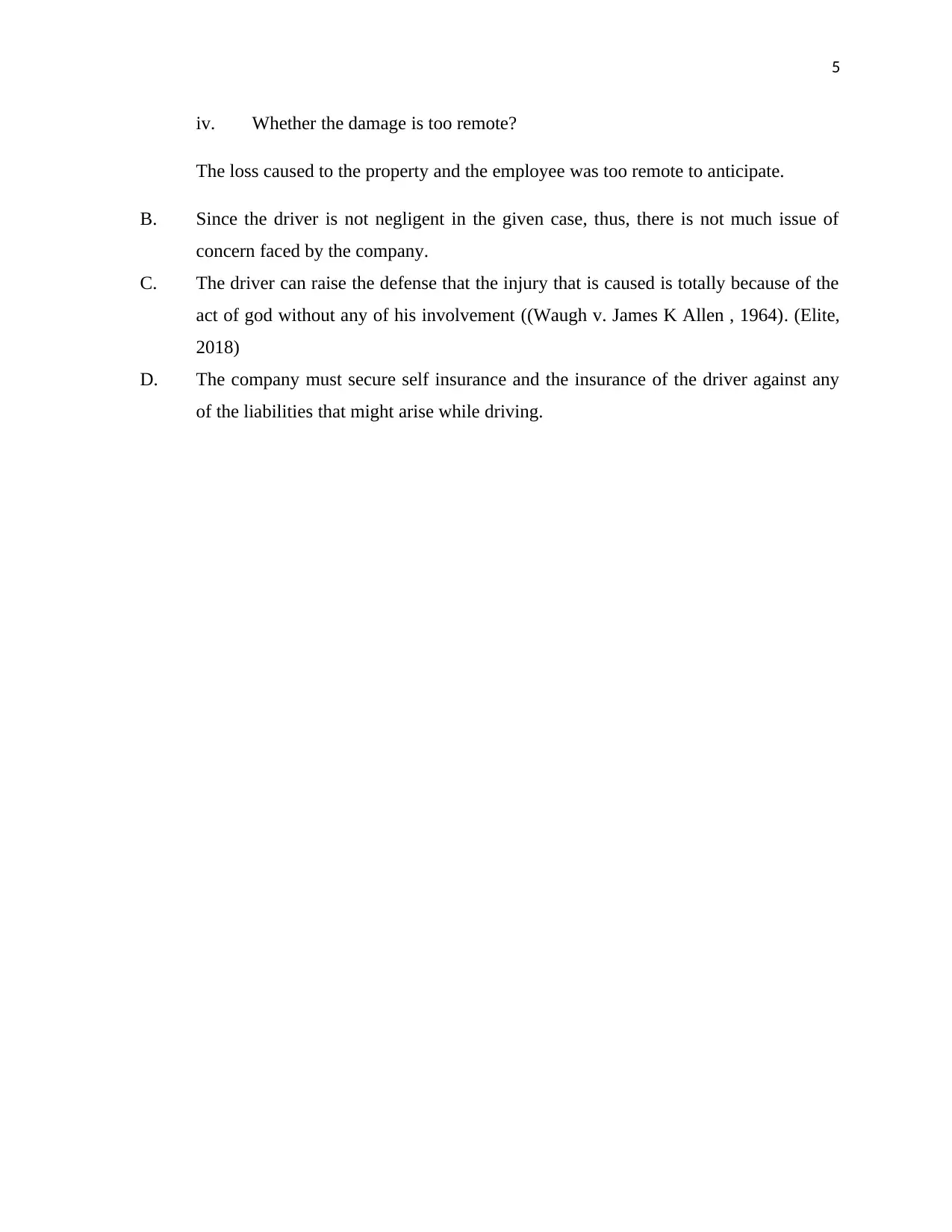
5
iv. Whether the damage is too remote?
The loss caused to the property and the employee was too remote to anticipate.
B. Since the driver is not negligent in the given case, thus, there is not much issue of
concern faced by the company.
C. The driver can raise the defense that the injury that is caused is totally because of the
act of god without any of his involvement ((Waugh v. James K Allen , 1964). (Elite,
2018)
D. The company must secure self insurance and the insurance of the driver against any
of the liabilities that might arise while driving.
iv. Whether the damage is too remote?
The loss caused to the property and the employee was too remote to anticipate.
B. Since the driver is not negligent in the given case, thus, there is not much issue of
concern faced by the company.
C. The driver can raise the defense that the injury that is caused is totally because of the
act of god without any of his involvement ((Waugh v. James K Allen , 1964). (Elite,
2018)
D. The company must secure self insurance and the insurance of the driver against any
of the liabilities that might arise while driving.

6
Bibliography
(Waugh v. James K Allen (1964).
Armsden v. Kent Police (2009).
Carmarthenshire CC v. Lewis (1995).
Elite. (2018). The tort of negligence. Retrieved November 13, 2018, from
https://elite.law.ac.uk/bbcswebdav/institution/1718/manual_bank/ou/
w300_law_agreement_rights_and_responsibilities/W300%20Manual%202%20%2818th%20ed
%29%20Unit%208-10.pdf
Mansfield v. Weetabix (1998).
Resurfice Corp. v. Hanke (2017).
Spagnolo et al. v. Margesson's Sports Ltd et al (1983).
Bibliography
(Waugh v. James K Allen (1964).
Armsden v. Kent Police (2009).
Carmarthenshire CC v. Lewis (1995).
Elite. (2018). The tort of negligence. Retrieved November 13, 2018, from
https://elite.law.ac.uk/bbcswebdav/institution/1718/manual_bank/ou/
w300_law_agreement_rights_and_responsibilities/W300%20Manual%202%20%2818th%20ed
%29%20Unit%208-10.pdf
Mansfield v. Weetabix (1998).
Resurfice Corp. v. Hanke (2017).
Spagnolo et al. v. Margesson's Sports Ltd et al (1983).
⊘ This is a preview!⊘
Do you want full access?
Subscribe today to unlock all pages.

Trusted by 1+ million students worldwide
1 out of 6
Related Documents
Your All-in-One AI-Powered Toolkit for Academic Success.
+13062052269
info@desklib.com
Available 24*7 on WhatsApp / Email
![[object Object]](/_next/static/media/star-bottom.7253800d.svg)
Unlock your academic potential
© 2024 | Zucol Services PVT LTD | All rights reserved.





